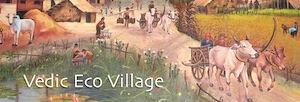The Gurukula Colony will feature many aspects of the traditional Vedic culture centered on the traditional educational system of Gurukula. Traditionally, gurukula was for the education of not only brahmanas, but also ksatriyas and vaisyas. Our Gurukula Colony will cater to both brahminical training and ksatriya training. Since the Gurukula Colony will also be home for a Varnasrama College, we will also have courses and activities for the other two varnas, namely Vaisya and Sudra.
The center of the Gurukula Colony will be the Mandir. However, before building a temple we will first focus on building a Goshala where we plan to keep a few cows for the pleasure and service of the Lord. Once the Goshala is operational, we will then concentrate on building a Prabhupada Memorial for His Divine Grace. It is only after these two facilities are manifest will we concentrate on the temple. Temple activities will be there of course from the beginning, but the actual structure will manifest after the Goshala and Prabhupada Memorial.
We will gradually introduce the following activities as the project unfolds: 1) Go Shala, 2) Yoga Shala, 3) Yajna Shala, and 4) Path Shala.
1) Go Shala
The Go Shala will be the home for a few cows, ideally Gir cows, depending on their availability. As in the original Vrindavan, cows play a central role in the lives of the Brajavasis, similarly, we plan to focus all the activities within our Vedic Eco Village around cows and agriculture. For the maintenance and good health of the cows we will have designated grazing areas and when the weather permits, will arrange for the cows to be out grazing most of the day. In connection with cows, we plan to introduce Panchagavya products such as body soaps, incense, washing soap, tooth powder, phenol and other products.
2) Yoga Shala
The Yoga Shala will be located to the southeast of the colony, close to the Yajna Shala. We will build small wooden platforms measuring 8 feet by 8 feet for students to daily practice Yoga Asanas. These will be conducted in the mornings beginning with Surya Namaskara and other practices.
3) Yajna Shala
Traditionally in Gurukulas and asramas, the sadhus would keep a "permanent" fire going because daily in the morning the brahmanas would perform their daily puja. Wood continues to be added so that the fire remains in the form of "brazier" thus keeping the fire from extinguising.
Ashes are produced for these fires and can be used for different purposes, many for various Panchagavya products.
4) Path Shala
All Gurukulas provide daily academic education and training in what is traditionally referred to as a Path Shala. We plan to have simple structures where students will gather with the teacher to take up their studies. The Path Shala may have more than one structure to allow for different classes to be taken simultaneously. The Path Shala area will be located near the asrama for teachers in the southwest section of the Gurukula Colony, not too far from the Mandir compound.
- Log in to post comments
